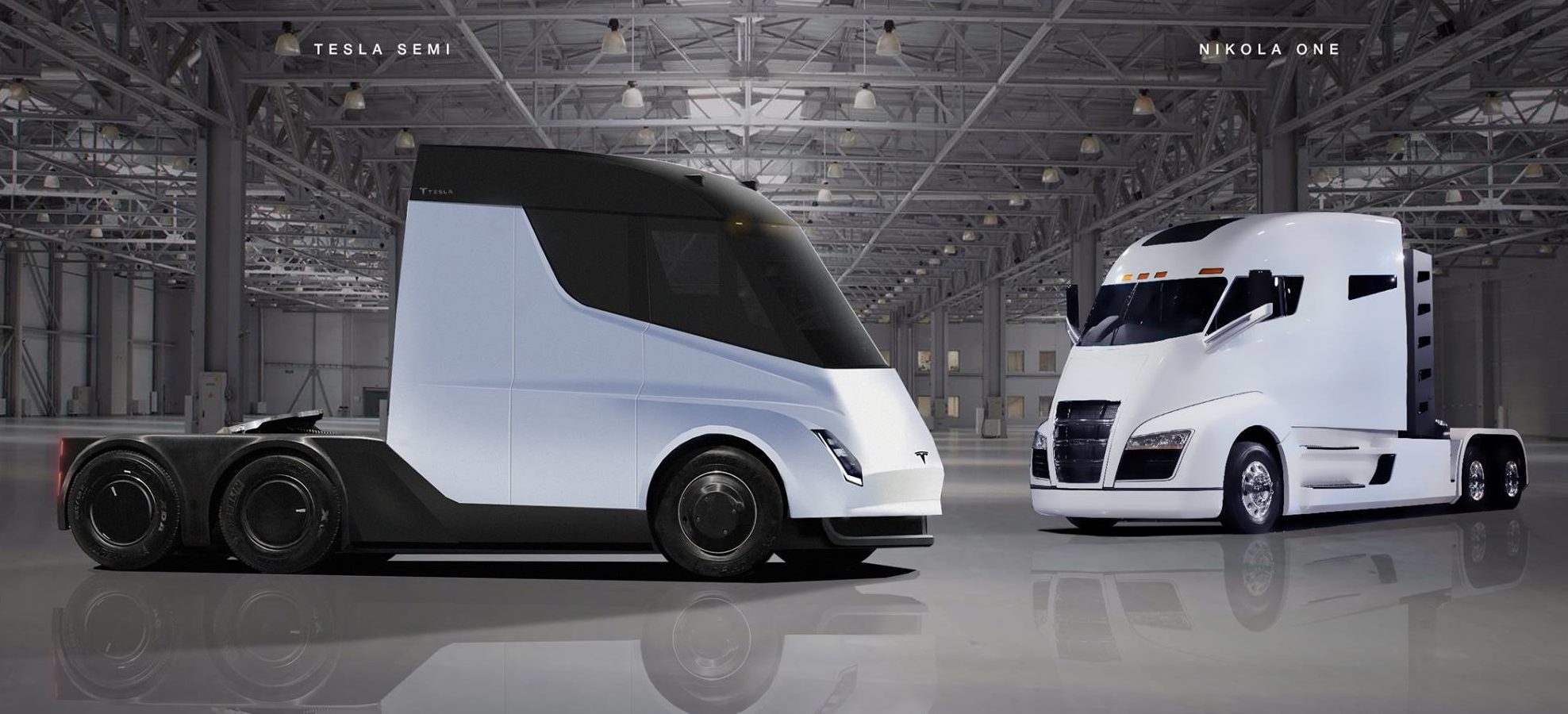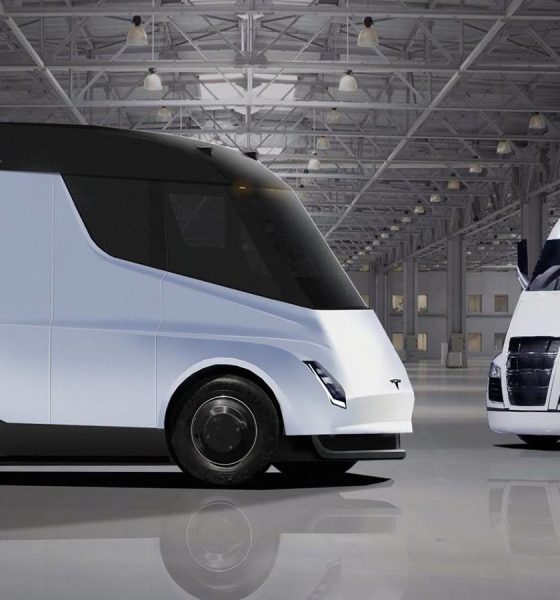

News
Nikola can ‘easily’ do all-electric trucks like Tesla Semi, says exec in interview
New Nikola Motor president Mark Russell recently provided some updates on the company’s efforts to establish its hydrogen refueling stations across the United States, as well as his thoughts about rivals like the Tesla Semi and other hybrid trucks like the modified Kenworth-Toyota T680 long-hauler that debuted at the Consumer Electronics Show in Las Vegas last January.
Russell, who used to serve as Worthington Industries’ president and chief operating officer, notes that Nikola is notably different from other ventures that he had been involved with in the past, thanks in part to the trucking startup’s pace. “We get so much done; it’s just dizzying,” he said.
Nikola Motor had changed directions several times over the past years. At one point, the company had announced plans for the production of a truck powered by hydrogen and natural gas, before shifting to an initiative aimed at developing hybrid battery-electric and fuel cell hydrogen long-haulers. Most recently, Nikola announced that it would also be producing battery-electric trucks, placing its vehicles in even more direct competition with the Tesla Semi, a vehicle that is expected to begin production late 2019 or sometime next year.

Speaking with trucking publication FreightWaves, Russell explained that the Tesla Semi would not be competing with its long-haul vehicles like the Nikola One, due to the Semi’s limited battery range. The Tesla Semi is offered at 300-mile and 500-mile variants, though Elon Musk has teased that improvements to the vehicle’s design will place the truck’s range closer to 600 miles per charge. This is impressive for a pure-electric truck, but still less than the range of the hydrogen-powered Nikola One, which is expected to have a range of over 1,000 miles. The Nikola President notes that the Tesla Semi is rather simple, and it is a vehicle that the trucking startup could easily do.
“Their truck is our truck with a bigger battery, and we can easily do that. It Nikola’s recent electric vehicle announcement is not as big a deal as people are making it out to be. It’s not a strategy shift. Our model is still attacking the long haul market. We will sell battery electric vehicles based on the same design, and they’ll be great vehicles for those applications. If Tesla can produce their truck and meet the specs, we’ll be competing with them in that market. Tesla doesn’t have anything to compete with us in long-haul,” he said.
Russell also asserted that Nikola would be producing all its hydrogen from renewable resources. The exec further added that the use of hydrogen, provided that it is drawn from renewable energy, is even more environmentally-friendly than the use of batteries to store energy.

“That’s the problem with renewables; they only generate when the wind blows, or the sun shines, and what do you do with them when you don’t need it? You have to store it. One solution is to buy expensive batteries that consume commodities scarce on this planet and then have hazardous waste when they are done. Or you can make hydrogen. Once you’ve made hydrogen and stored it, it can sit there forever. It doesn’t degrade. It doesn’t leak. And when you turn it back into electricity, it becomes water. It’s an elegant, beautiful, simple solution for storing energy, so much better than batteries. You break down water; you put it back together,” he said.
With regards to other hybrid trucks that have been unveiled recently, such as the modified Kenworth-Toyota T680 long-hauler that debuted at the CES, Russell proved mostly unimpressed, stating that such projects are more like a Frankenstein monster that’s cobbled together from existing components. The executive explained that Nikola’s trucks would be designed from the ground up to be environmentally-friendly vehicles, and this is something that will make them truly unique.
Nikola has a tendency to be quite protective of its vehicles. Last year, the trucking startup filed a lawsuit against Tesla claiming that the Semi’s design was copied from the Nikola One. Neither Nikola nor Tesla has issued an official update about the case so far. Nikola Motor is currently preparing for its Nikola World Exhibition this coming April 16-17, where the company is expected to showcase its vehicles like the Nikola Two daycab and the Nikola Tre, a vehicle designed for European markets.

News
Tesla China quietly posts Robotaxi-related job listing
Tesla China is currently seeking a Low Voltage Electrical Engineer to work on circuit board design for the company’s autonomous vehicles.

Tesla has posted a new job listing in Shanghai explicitly tied to its Robotaxi program, fueling speculation that the company is preparing to launch its dedicated autonomous ride-hailing service in China.
As noted in the listing, Tesla China is currently seeking a Low Voltage Electrical Engineer to work on circuit board design for the company’s autonomous vehicles.
Robotaxi-specific role
The listing, which was shared on social media platform X by industry watcher @tslaming, suggested that Tesla China is looking to fill the role urgently. The job listing itself specifically mentions that the person hired for the role will be working on the Low Voltage Hardware team, which would design the circuit boards that would serve as the nervous system of the Robotaxi.
Key tasks for the role, as indicated in the job listing, include collaboration with PCB layout, firmware, mechanical, program management, and validation teams, among other responsibilities. The role is based in Shanghai.
China Robotaxi launch
China represents a massive potential market for robotaxis, with its dense urban centers and supportive policies in select cities. Tesla has limited permission to roll out FSD in the country, though despite this, its vehicles have been hailed as among the best in the market when it comes to autonomous features. So far, at least, it appears that China supports Tesla’s FSD and Robotaxi rollout.
This was hinted at in November, when Tesla brought the Cybercab to the 8th China International Import Expo (CIIE) in Shanghai, marking the first time that the autonomous two-seater was brought to the Asia-Pacific region. The vehicle, despite not having a release date in China, received a significant amount of interest among the event’s attendees.
Elon Musk
Elon Musk and Tesla AI Director share insights after empty driver seat Robotaxi rides
The executives’ unoccupied tests hint at the rapid progress of Tesla’s unsupervised Robotaxi efforts.

Tesla CEO Elon Musk and AI Director Ashok Elluswamy celebrated Christmas Eve by sharing personal experiences with Robotaxi vehicles that had no safety monitor or occupant in the driver’s seat. Musk described the system’s “perfect driving” around Austin, while Elluswamy posted video from the back seat, calling it “an amazing experience.”
The executives’ unoccupied tests hint at the rapid progress of Tesla’s unsupervised Robotaxi efforts.
Elon and Ashok’s firsthand Robotaxi insights
Prior to Musk and the Tesla AI Director’s posts, sightings of unmanned Teslas navigating public roads were widely shared on social media. One such vehicle was spotted in Austin, Texas, which Elon Musk acknowleged by stating that “Testing is underway with no occupants in the car.”
Based on his Christmas Eve post, Musk seemed to have tested an unmanned Tesla himself. “A Tesla with no safety monitor in the car and me sitting in the passenger seat took me all around Austin on Sunday with perfect driving,” Musk wrote in his post.
Elluswamy responded with a 2-minute video showing himself in the rear of an unmanned Tesla. The video featured the vehicle’s empty front seats, as well as its smooth handling through real-world traffic. He captioned his video with the words, “It’s an amazing experience!”
Towards Unsupervised operations
During an xAI Hackathon earlier this month, Elon Musk mentioned that Tesla owed be removing Safety Monitors from its Robotaxis in Austin in just three weeks. “Unsupervised is pretty much solved at this point. So there will be Tesla Robotaxis operating in Austin with no one in them. Not even anyone in the passenger seat in about three weeks,” he said. Musk echoed similar estimates at the 2025 Annual Shareholder Meeting and the Q3 2025 earnings call.
Considering the insights that were posted Musk and Elluswamy, it does appear that Tesla is working hard towards operating its Robotaxis with no safety monitors. This is quite impressive considering that the service was launched just earlier this year.
Elon Musk
Starlink passes 9 million active customers just weeks after hitting 8 million
The milestone highlights the accelerating growth of Starlink, which has now been adding over 20,000 new users per day.

SpaceX’s Starlink satellite internet service has continued its rapid global expansion, surpassing 9 million active customers just weeks after crossing the 8 million mark.
The milestone highlights the accelerating growth of Starlink, which has now been adding over 20,000 new users per day.
9 million customers
In a post on X, SpaceX stated that Starlink now serves over 9 million active users across 155 countries, territories, and markets. The company reached 8 million customers in early November, meaning it added roughly 1 million subscribers in under seven weeks, or about 21,275 new users on average per day.
“Starlink is connecting more than 9M active customers with high-speed internet across 155 countries, territories, and many other markets,” Starlink wrote in a post on its official X account. SpaceX President Gwynne Shotwell also celebrated the milestone on X. “A huge thank you to all of our customers and congrats to the Starlink team for such an incredible product,” she wrote.
That growth rate reflects both rising demand for broadband in underserved regions and Starlink’s expanding satellite constellation, which now includes more than 9,000 low-Earth-orbit satellites designed to deliver high-speed, low-latency internet worldwide.
Starlink’s momentum
Starlink’s momentum has been building up. SpaceX reported 4.6 million Starlink customers in December 2024, followed by 7 million by August 2025, and 8 million customers in November. Independent data also suggests Starlink usage is rising sharply, with Cloudflare reporting that global web traffic from Starlink users more than doubled in 2025, as noted in an Insider report.
Starlink’s momentum is increasingly tied to SpaceX’s broader financial outlook. Elon Musk has said the satellite network is “by far” the company’s largest revenue driver, and reports suggest SpaceX may be positioning itself for an initial public offering as soon as next year, with valuations estimated as high as $1.5 trillion. Musk has also suggested in the past that Starlink could have its own IPO in the future.








